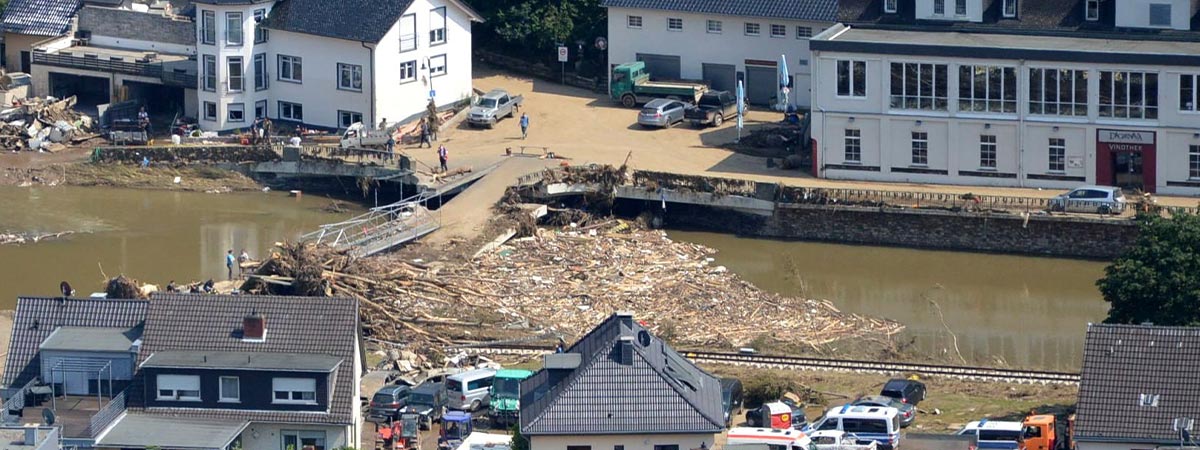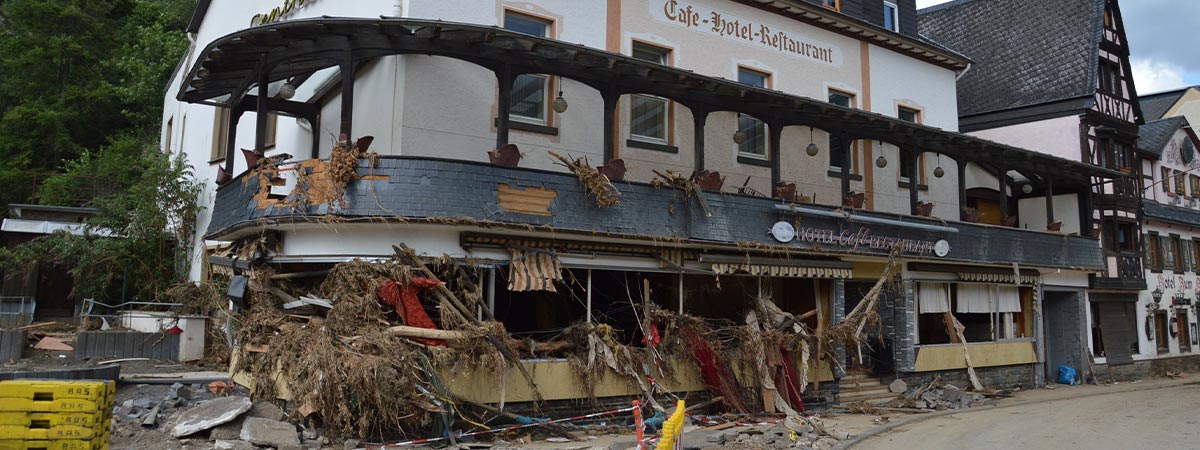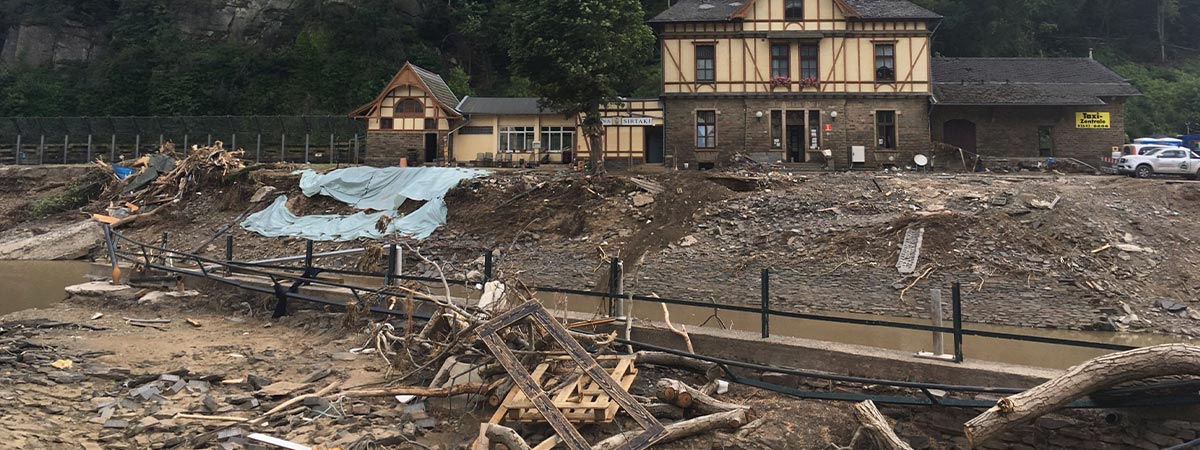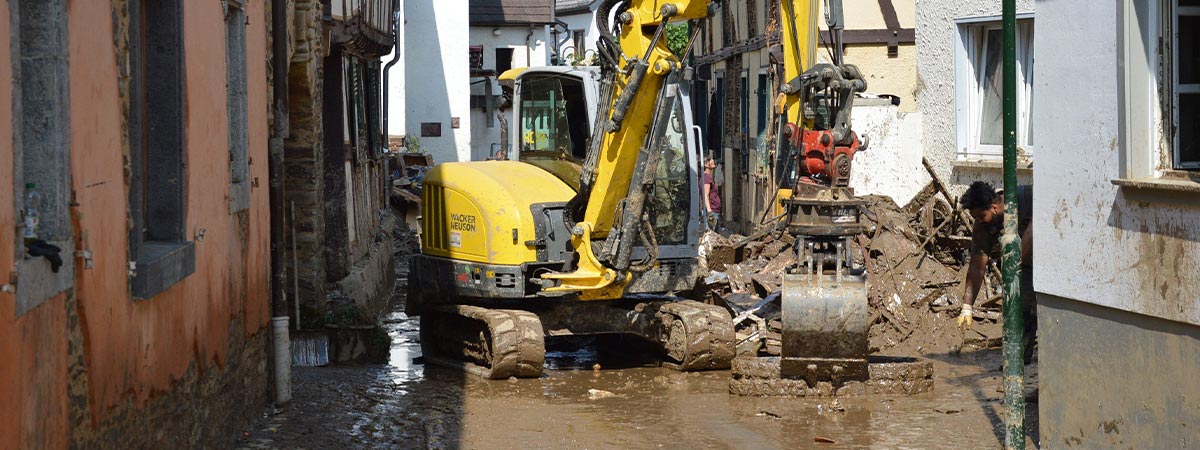On the street corner in Dernau lies a wine tank, swirled around like a toy, one street further a car is hanging up in a tree. The streets are covered in mud, wrecked cars are piled up on the railway embankment, a sweet stench of oil and mould hangs in the air - devastation, metre-high mountains of debris as far as the eye can see. Excavators, tractors and heavy trucks roar. They clear, they dredge mud, and they tear down what can no longer be saved. And that is a lot. In the wine village of Dernau on the Ahr, nothing is as it once was.
Late in the evening of 14 July, a tidal wave of unimaginable proportions broke over the idyllic Ahr valley. In the days before, heavy rain had poured down on the region for days, and the already rain-saturated soils could no longer hold the masses of water. It was Wednesday evening when the water level of the Ahr rose, slowly at first, then faster and faster: from about 8 p.m. onwards, a flood wave piled up on the upper reaches of the Ahr.
 |
At 8.15 pm, the official Altenahr gauge reported a water level of 5.09 metres. It was its last report. Because at 8.45 p.m. it no longer existed, the masses of water had swept it away. The water level of the Ahr is normally around 80 centimetres low, you could get to the other bank on foot. But that night, nature unleashed a flood wave up to eight metres high that swept away houses and caused unimaginable damage.
At a house in the main street in Dernau, mud-covered people clear bottles from a pitch-black cellar; they are the last remains in the Bertram winery. Bottle storage and wine cellar are "completely destroyed and everything is gone or broken", writes winemaker Julia Bertram, former German Wine Queen, on Facebook days after the disaster. She and the whole family are doing well, but the family's houses are "uninhabitable and partly inaccessible." It is their only sign of life so far. The traumatised people are not available for journalists, they have to save their existence.
The short statement was one of the first signs of life from the winegrowers in the Ahr valley. Almost all wine-growing businesses have suffered dramatic damage: machinery, wine warehouses, homes, vehicles, wine taverns and guesthouses - many winegrowers have lost everything. The flood tsunami destroyed 62 bridges along the Ahr and severely damaged 13 others. The bridge in Dernau, which led across to the Dagernova wine cooperative, was also literally torn apart by the force of the water.
 |
The vinotheque of the Mayschoß-Altenahr winegrowers' cooperative is also a field of rubble. "The entire building has been destroyed and we currently don't know where to help and start first," the oldest winegrowers' cooperative in Germany also writes on Facebook: "The situation in Mayschoß and along the entire Ahr is terrible. For a fortnight the world has stood still for us and everything has changed."
The flood wave destroyed the entire infrastructure along the 40-kilometre-long valley. Electricity, water and telephone are dead. Some places, such as Mayschoß, were cut off from the outside world for days - the flood also destroyed roads and railways along the valley, and the Ahrtal railway no longer exists. The area around Altenahr railway station is a landscape of ruins: the water has left the Hotel zur Post in ruins, trees and debris protrude from the Hotel Central next door. Acrid dust lies over the entire valley, the water of the Ahr is highly contaminated, the authorities warn of epidemic danger. Even specialists with decades of experience from the German Federal Agency for Technical Relief (THW) and the German Armed Forces are stunned: "I have completed dozens of serious disaster missions, also abroad, but I have never experienced anything like this," says a THW employee who wishes to remain unnamed.
"This is a real apocalypse in the Ahr," says Steffen Christmann, President of the Association of Prädikat Wine Estates (VDP) to wein.plus: "When you see these pictures, the metre-high mountains of rubble up to the first floor, it's hard to keep your composure." There are about 65 full-time wineries in the red wine-growing region, including such well-known names as Jean Stodden and Meyer-Näkel.
 |
"The Meyer-Näkel winery is almost a total loss," Christmann reports, "there's not one stone left standing on another." The new hall on the river was a victim of the floods. 300 barrique barrels full of wine were swept away by the floods, some barrels were still found several kilometres away. "At the moment we are in the process of saving what can be saved," write Dörte and Meike Näkel on their Facebook page: "The vinotheque and the old wine cellar with treasure chamber as well as the office were completely flooded and buried under masses of mud." Production hall, tank farm, machine hall and bottle store - all torn away. They too are not available to talk to in person.
The people in the valley are hollow-eyed, many are in shock or traumatised. 134 people lost their lives in the flood night, 59 are still missing. Many cannot even grasp their experience, let alone put it into words. "We still have our cellar, but no more equipment. We are currently salvaging our barrels," reports Marita Heil from the J.J. Adeneuer winery in Ahrweiler: "The water in our hallway was 1.50 metres high. Office, warehouse, everything was completely flooded."
In Ahrweiler, the floodwaters rose up to six metres, there was hardly a house that was not under water up to the first floor - even in streets that are far away from the Ahr. There is hardly a house that does not now have piles of rubble and destroyed household goods lying in front of its doors.
 |
And yet the winegrowers urgently need to look after the vineyards now: Most of the vineyards on the steep slopes of the valley are green and intact, but the moisture of the past weeks has massively increased the fungal pressure, threatening infestation with downy mildew and other fungal diseases. For many farms, the 2021 harvest is now also in jeopardy.
"The flood hits the Ahr valley right in the heart," says Peter Kriechel, chairman of Ahrwein e.V.. Viticulture, as the supporting economic pillar of the entire region, is no longer standing in this way. "But we are currently experiencing just as great a flood of willingness to help and compassion," Kriechel emphasises. Whole squads of winegrowers and their employees from all parts of the country are rushing to the aid of their colleagues on the Ahr, with machines as well as manpower. They come from the Palatinate, Franconia, Rhinehesse and the Rheingau.
And there are the countless volunteers who flock to the Ahr valley day after day to help. Complete strangers from all over the country simply lend a hand, shovel mud from cellars, form chains of buckets and help where there is need. "It's a solidarity that's unbelievable," says Marita Heil, "we get goosebumps with emotion."
And the Ahr wineries themselves now offer wine packages with so-called "flood wines": mud-smeared wine bottles salvaged from the cellars. "Some of the best bottles of the excellent and appreciated Ahr wines," write the Ahr winegrowers themselves on their homepage: "We call them the flood wines - our worst vintage."
 |